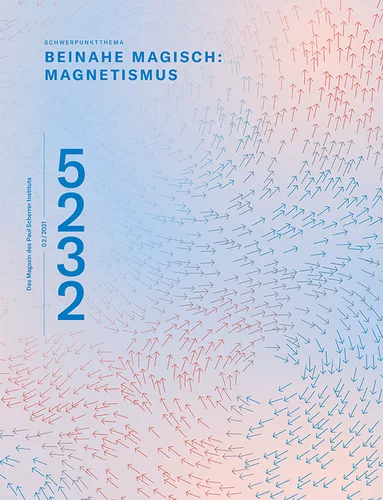In accelerators, strong magnets keep elementary particles on course and supply experiment stations with the beams needed to look deep inside materials. With the knowledge gained in this way, PSI researchers develop new applications for technology and medicine.
In the middle of a large workshop stands a solid, 50-centimetre high metal frame, mounted on a concrete block. It is the mount, the so-called yoke, for a new magnet – a prototype that is being assembled at PSI. "We fill the yoke with small blocks of permanent magnets, and we have to be very careful," says Stéphane Sanfilippo, head of the Magnet Section at PSI: "The forces at work here are enormous. You could break your hand in a second." The force with which two of these small magnets stick together corresponds to a weight of 180 kilograms. The blocks, made of an alloy of the elements neodymium, iron, and boron, are part of the design that PSI specialists developed on the computer. The permanent magnets are among nearly 1,000 magnets in all that are being built for the upgrade of the Swiss Light Source SLS. The particle accelerator, which has been housed in a large, UFO-shaped building in Villigen since 2001, is being renovated to provide even better X-ray light for research from 2025 on, as SLS 2.0. At the end of last year, the Swiss Federal Council gave the go-ahead to fund this project with 99 million Swiss francs. This will improve and above all accelerate work on new scientific questions, for example in biomolecular or materials research.
Strong magnets can be found in every particle accelerator at PSI: including the world's most powerful proton accelerator HIPA, which supplies protons to three other large research facilities, the spallation neutron source SINQ, the Swiss Muon Source SμS, and the Swiss research infrastructure for particle physics CHRISP; the X-ray free-electron laser SwissFEL; the COMET cyclotron for proton therapy; and SLS. In the accelerators, electromagnets normally guide the particles along their path. They consist of a coil of wound copper wire. When current flows through the coil, a magnetic field is created. The advantages of electromagnets: In contrast to permanent magnets, they can be switched on and off, and their field strength can be regulated by the flow of current. Some of the magnets for SLS 2.0 will still be electromagnets as in the original machine. "However, this is the first time that we are also building permanent magnets in series for a large accelerator at PSI," says Sanfilippo. "This allows us to save space." That's because permanent magnets need neither a power connection nor water, which is used to keep electromagnets cool. In addition, power consumption to feed the magnets of SLS 2.0 can be massively reduced compared to SLS. Thanks to the permanent magnets, around 10,000 kilowatt hours, or 1,000 Swiss francs in electricity costs, can be saved per day of operation. This means that SLS 2.0 will be "greener" in operation.
The forces at work here are enormous. You could break your hand in a second.
Develop, build, and test
In the back of the workshop, Sanfilippo's team is developing a third type of magnet that can be used to generate especially strong fields. For this, superconducting material is used. This transports the electricity without loss but needs to be cooled to extremely low temperatures. Compact superconducting magnets will not only be used in SLS 2.0, but also in the design study for the large planned accelerator Future Circular Collider (FCC) at the European particle research center CERN near Geneva. As part of the Swiss research network CHART (Swiss Accelerator Research and Technology), PSI is contributing to technology development. "Here we are building up the infrastructure and knowledge for the development of superconducting accelerator magnets," says Sanfilippo, "and in doing so, we can take advantages of synergies between the projects for PSI and CERN."
On the other side, separated from the rest of the workshop, there is a room with a wide variety of installations that at first glance look quite exotic. A board warns anyone with a pacemaker about strong magnetic fields. "In this zoo of measuring devices, we test all the magnets, both those we've made and those supplied by outside companies," explains Sanfilippo. Only when the magnets actually meet all specifications will the technicians install them in SLS 2.0.
The numerous compact magnets in the renovated accelerator will guide the electrons along an improved circular path with softer curves than before. In this way, the quality of the X-rays, which are generated when the electrons change direction, can be improved by orders of magnitude. Valerio Scagnoli is already looking forward to it. The experienced scientist and his team use SLS to make magnetic structures in materials visible in the smallest detail and even in 3-D. "Today we need a day or two for an experiment; in the future we will be ten or even a hundred times faster," says Scagnoli. "And thanks to the upgrade, the spatial resolution of the images will increase dramatically."
A compass that points west
Valerio Scagnoli is a member of the Mesoscopic Systems Group, a joint laboratory of PSI and ETH Zurich headed by Laura Heyderman. Experts understand "mesoscopic" to mean the size range between millionths of a millimetre (nanometres) and thousandths of a millimetre (micrometres). With the help of SLS, researchers from Heyderman's group discovered a special magnetic interaction at the level of nanoscopic structures made up of just a few atomic layers.
Magnets are usually characterised by the fact that they have a north pole and a south pole. If two magnets are held close to each other, the opposite poles attract and the like poles repel each other. That's why magnetic needles, such as those found in compasses, align themselves in Earth's magnetic field in such a way that the cardinal directions north and south can be determined, and east and west can be derived from them. In the world we experience with our senses every day, this rule holds true. But that changes when you leave the macroscopic world and dive into the depths of much smaller dimensions.
There the atoms act like tiny compass needles and exhibit their effect over extremely short distances in the nanometre range, that is, a few millionths of a millimetre. Hence the researchers also speak of nanomagnets.
The phenomenon that the PSI researchers were able to observe is based on an interaction that physicists Igor Dzyaloshinskii and Toru Mariya predicted more than 60 years ago. With this interaction, the atomic compass needles align themselves not only in a north-south orientation, but also east-west. Where they point depends on how the atoms in their neighbourhood orient themselves. For example, if a group of atoms points north, the neighbouring group will always point west. If a group of atoms points south, then the neighbouring atoms orient themselves to the east.
Under the influence of magnetic fields or electrical currents, these orientations can change direction, from north to south and vice versa. The neighbouring groups of atoms then reorient themselves accordingly, from west to east or vice versa. What is extraordinary is that this interaction takes place laterally, that is, sideways in a plane. Up to now, researchers had only been able to detect comparable couplings between nanomagnets vertically, that is, with groups of atoms arranged one on top of the other. By means of the newly discovered phenomenon, it may be possible to build new, more efficient computer memories and switches, which in turn would boost the performance of microprocessors.
Intelligent microrobots
Also in Heyderman's group, researchers have developed tiny magnetic systems with novel characteristics. "In the future, intelligent microrobots might navigate through the blood vessels in the human body and perform biomedical tasks," says Jizhai Cui, who worked in Heyderman's group for four years as a postdoc and now is building up a research team at the Chinese Fudan University in Shanghai. The tiny machines could, for example, target and kill cancer cells.
The researchers at PSI have already demonstrated how this would work in principle, using a bird-shaped robot just a few micrometres in size that was able to flutter, arch its neck, and glide to the side. They had placed tiny cobalt magnets on thin layers of silicon nitride. "If you equip microrobots with nanomagnets, they can react like a compass to externally applied magnetic fields," explains Cui: "As if driven by a motor, the microrobots can move forward when the magnetic field rotates." One of the next steps now is to make the microrobots biodegradable, says the researcher, adding: "I am very much looking forward to a collaboration between Fudan University and PSI."
PSI researchers developed another material with amazing properties in cooperation with ETH Zurich: a material with shape memory. If you force this composite into a certain shape and then subject it to a magnetic field, it will retain that shape. Only when the magnetic field is removed does the material return to its original shape. Up to now, comparable materials have consisted of a polymer and embedded metal particles. Instead, the researchers at PSI and ETH Zurich added the magnetic particles to the polymer using droplets composed of water and glycerine. In this way they created a dispersion similar to that known from milk. In the new material, droplets of the liquid with the magnetic particles are distributed in a similarly fine manner. "Since the magnetically sensitive phase dispersed in the polymer is a liquid, the forces generated when a magnetic field is applied are much greater than previously known," explains Laura Heyderman. If a magnetic field acts on the composite, it stiffens.
A great many medical, aerospace, electronics, and robotics applications are conceivable for shape-memory materials. Catheters pushed through blood vessels to the surgical site in the body during minimally invasive operations would be able to change their rigidity. The advantage is that they would only have to become firm when necessary, and therefore – for example when gliding through a blood vessel – they should cause fewer side-effects such as thrombosis. In aerospace applications, shape-memory materials are sought after as way to enable tyres for exploration vehicles to inflate or fold up again on their own. In electronics, soft functional materials could serve as flexible power or data lines, for example in so-called wearables – devices are worn in clothing or directly on the body. Shape memory also opens up new possibilities: In robotics, for example, shape-memory materials can perform mechanical movements without a motor.
Colossal magnets weighing 250 tonnes
When it comes to the topic of magnetism at PSI, the leaps across the range of dimensions – from ultrasmall to truly gigantic – are enormous. You can see that immediately upon entering the building complex right next to the large workshop where Stéphane Sanfilippo's team is developing new magnets for the SLS upgrade. This is where the oldest fully functional large research facility at PSI is located: the high-intensity proton accelerator HIPA. The eight huge, turquoise-coloured electromagnets of the ring accelerator, dating from 1974, weigh 250 tonnes each. "Maintaining these and all the other magnets in PSI's accelerators and laboratories also one of our tasks," says Sanfilippo. "It is our goal to keep downtimes as short as possible."
Optimal cutting of electrical steel
The protons from HIPA hit a lead block in the spallation neutron source SINQ and knock neutrons out of the atomic nuclei. "Neutrons can easily penetrate matter and are therefore well suited for looking inside materials," explains Markus Strobl, head of the Applied Materials Group at PSI and professor at the University of Copenhagen. "And although the neutrons are electrically neutral, they have a magnetic moment and interact with magnetic fields." This can render visible the areas or domains in a material where magnetisation takes place in a uniform direction: for example in so-called electrical steels, products with a large market share because they are used for electric motors, generators, and transformers.
The material I work with is very special.
"The design of the magnetic domains in these steels is important for the efficiency of the machines," says Strobl. Images of the interior of the material showed that cutting electrical steel to size negatively affects the magnetic properties at the edges. "We then investigated, on behalf of an Austrian company, how one could improve the cutting technology and thus avoid energy losses," Strobl says. These studies on electrical steels are now to be continued in cooperation with the German Fraunhofer Gesellschaft.
Little spirals with great potential
The images made by Strobl and his group have a resolution of a thousandth of a millimetre to a centimetre. The length scale Marisa Medarde is interested in is in the millionths of a millimetre, the size of an atom. Head of the Physical Properties of Materials Group, Medarde says, "The material I work with is very special." It contains tiny magnets that are arranged in a spiral. These spirals can be detected with the help of the neutrons at SINQ. Researchers suspect that a particularly desirable property comes along with this: The magnetisation of the material can be controlled by an electric field, which is much simpler and more energy-efficient than if a magnetic field is required.
Such materials are therefore considered candidates for future data storage technology. Medarde's material, with the chemical formula YBaCuFeO5, is especially promising. That's because up to now such magnetic spirals have only been detected at extremely low temperatures. "Our spirals exist at room temperature," the researcher says. "In addition, you can change them relatively easily, which is completely unexpected." Her trick: She first heats the material to more than 1,000 degrees and then throws it directly into liquid nitrogen at almost minus 200 degrees. In a next step, Medarde and her team want to show that the material really does have the desired properties. The use of such multiferroic materials is expected to result in more energy-efficient computers.
Thus the power of magnetism, which can seem almost magical, unites a great many research efforts at PSI – regardless of whether they are concerned with structures in computers, with novel materials for medicine and technology, or with gigantic facilities that accelerate tiny particles.
Text: Barbara Vonarburg
Copyright
PSI provides image and/or video material free of charge for media coverage of the content of the above text. Use of this material for other purposes is not permitted. This also includes the transfer of the image and video material into databases as well as sale by third parties.




